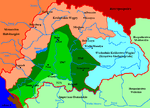Peace of Pressburg (1491)
The second Peace of Pressburg (also known as the Treaty of Pressburg) was a peace treaty concluded in Pressburg (then known as Pozsony in Hungarian and now as Bratislava, Slovakia) that brought a resolution to the earlier Austrian-Hungarian War (1477-1488). It was signed on 7 November 1491 between Holy Roman Emperor Maximilian I and King Vladislaus II of Bohemia and Hungary. Under this agreement, Vladislaus renounced his claim on Lower Austria and agreed that Maximilian should succeed to the Hungarian crown if Vladislaus left no legitimate male issue. Vladislaus did have a son in 1506, however, so this condition had no effect.
The assembly of nobility of the Kingdom of Hungary that led to the treaty had gathered a total of 63 dignitaries from the Kingdom of Bohemia and the Kingdom of Hungary.[1] The treaty reiterated an earlier agreement about royal succession that had been reached by Maximilian's father, Holy Roman Emperor Friedrich III, with Mathias Corvinus of Hungary.[2]
References
- ↑ Smiljanić, Franjo (December 2007). "Croatian medieval sources on the status and function of župan (iupanus) between the ninth and sixteenth centuries". Historical Contributions (in Croatian). Croatian Institute of History. 33 (33): 60. ISSN 0351-9767. Retrieved 2012-06-26.
- ↑ Hye, Franz-Heinz (November 1993). "Zur Geschichte des Staatswappens von Kroatien und zu dessen ältester Darstellung in Innsbruck". Bulletin d'archives (in German and Croatian). Croatian State Archives (36): 145–146. ISSN 0570-9008. Retrieved 2012-06-26.
